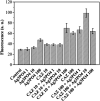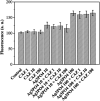Bifunctional nano-Ag3PO4 with capabilities of enhancing ceftazidime for sterilization and removing residues
- PMID: 35520599
- PMCID: PMC9064663
- DOI: 10.1039/c9ra01969c
Bifunctional nano-Ag3PO4 with capabilities of enhancing ceftazidime for sterilization and removing residues
Abstract
Since the efficacy of antibiotics towards bacteria is decreasing over time, the rising of antibiotic emission has become an increasingly grave issue. In this study, we proposed an integrated antibacterial nanotechnology without pollution residues, which synergistically enhances the antibacterial activity of ceftazidime by using the inorganic nano-Ag3PO4, and subsequently removes drug residues by photocatalysis. Ag3PO4 were synthesized using a simple ion-exchange method without any reducing agent or protectant. The combined antibacterial activity of Ag3PO4 and 22 kinds of antibiotics against Escherichia coli was first studied. The results showed that Ag3PO4 and ceftazidime exhibited the best synergistic effect. Next, the synergy mechanism was proposed, the non-chemical bond forces between Ag3PO4 and ceftazidime was determined by zeta potential analyzer, X-ray photoelectron spectroscopy (XPS) and infrared spectroscopy (IR). The interaction between antimicrobials and bacteria was further demonstrated by surface plasma resonance spectroscopy (SPR), scanning electron microscopy (SEM) and propidium iodide (PI) staining. In addition, the production of reactive oxygen species (ROS), the induction of oxidative stress and dissolution of silver ions in Ag3PO4 were studied and found out that only under light, could the ROS be generated. In conclusion, the synergistic effect of Ag3PO4 and ceftazidime is responsible for the joint destruction of cell wall.
This journal is © The Royal Society of Chemistry.
Conflict of interest statement
There are no conflicts to declare.
Figures












Similar articles
-
Highly flame-retardant materials of different divalent metal ions alginate/silver phosphate: Synthesis, characterizations, and synergistic phosphorus-polymetallic effects.Int J Biol Macromol. 2023 Aug 30;247:125834. doi: 10.1016/j.ijbiomac.2023.125834. Epub 2023 Jul 13. Int J Biol Macromol. 2023. PMID: 37453641
-
Chloride ion-driven transformation from Ag3PO4 to AgCl on the hydroxyapatite support and its dual antibacterial effect against Escherichia coli under visible light irradiation.Environ Sci Pollut Res Int. 2016 Jul;23(13):13458-66. doi: 10.1007/s11356-016-6530-7. Epub 2016 Mar 30. Environ Sci Pollut Res Int. 2016. PMID: 27026549
-
Antibacterial cotton fabrics via immobilizing silver phosphate nanoparticles onto the chitosan nanofiber coating.Int J Biol Macromol. 2020 May 3;158:282-289. doi: 10.1016/j.ijbiomac.2020.04.258. Online ahead of print. Int J Biol Macromol. 2020. PMID: 32376255
-
Reactive-oxygen-species-mediated mechanism for photoinduced antibacterial and antiviral activities of Ag3PO4.J Anal Sci Technol. 2020;11(1):21. doi: 10.1186/s40543-020-00220-y. Epub 2020 Jun 11. J Anal Sci Technol. 2020. PMID: 32542115 Free PMC article.
-
Ag3PO4-based photocatalysts and their application in organic-polluted wastewater treatment.Environ Sci Pollut Res Int. 2022 Mar;29(13):18423-18439. doi: 10.1007/s11356-022-18591-7. Epub 2022 Jan 17. Environ Sci Pollut Res Int. 2022. PMID: 35038092 Review.
Cited by
-
Analyses of Experimental Dental Adhesives Based on Zirconia/Silver Phosphate Nanoparticles.Polymers (Basel). 2023 Jun 8;15(12):2614. doi: 10.3390/polym15122614. Polymers (Basel). 2023. PMID: 37376260 Free PMC article.
-
A novel approach for the synthesis of nanostructured Ag3PO4 from phosphate rock: high catalytic and antibacterial activities.BMC Chem. 2021 Jun 30;15(1):42. doi: 10.1186/s13065-021-00767-w. BMC Chem. 2021. PMID: 34193227 Free PMC article.
-
Electrochemical Preparation of Synergistic Nanoantimicrobials.Molecules. 2019 Dec 22;25(1):49. doi: 10.3390/molecules25010049. Molecules. 2019. PMID: 31877834 Free PMC article.
-
Rational Design of W-Doped Ag3PO4 as an Efficient Antibacterial Agent and Photocatalyst for Organic Pollutant Degradation.ACS Omega. 2020 Sep 11;5(37):23808-23821. doi: 10.1021/acsomega.0c03019. eCollection 2020 Sep 22. ACS Omega. 2020. PMID: 32984701 Free PMC article.
-
Synthesis of M-Ag3PO4, (M = Se, Ag, Ta) Nanoparticles and Their Antibacterial and Cytotoxicity Study.Int J Mol Sci. 2022 Sep 27;23(19):11403. doi: 10.3390/ijms231911403. Int J Mol Sci. 2022. PMID: 36232708 Free PMC article.
References
-
- Singh S. Gundampati R. K. Mitra K. Ramesh K. Jagannadham M. V. Misra N. Ray B. RSC Adv. 2015;5:81994–82004. doi: 10.1039/C5RA13286J. - DOI
LinkOut - more resources
Full Text Sources
Research Materials
Miscellaneous

